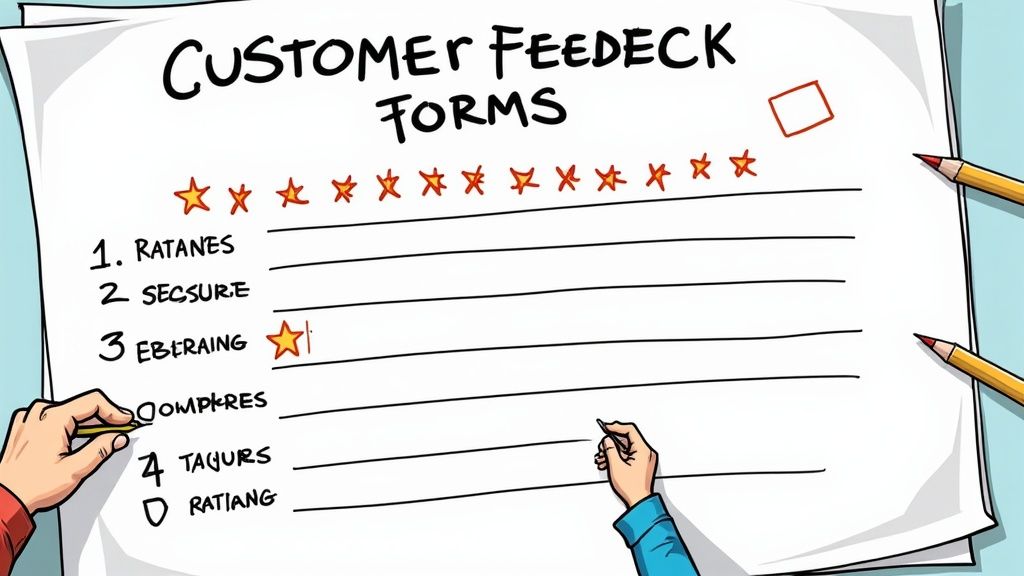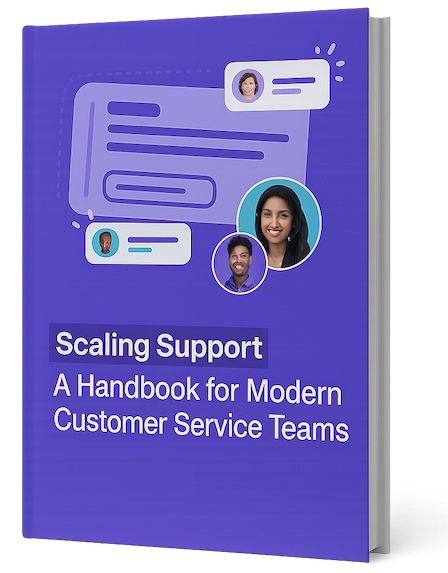Understanding the True Impact of Customer Satisfaction
Customer satisfaction directly influences business growth and long-term success. While many companies track basic satisfaction metrics, understanding its full impact requires looking at how it affects multiple aspects of your business performance.
The Link Between Satisfaction and Revenue
When customers are satisfied, they tend to stick around longer and spend more. This creates stable, predictable revenue that helps buffer against market changes and supports expansion into new offerings. The numbers tell a clear story – 93% of customers make repeat purchases from companies providing excellent service, and 89% buy again after positive experiences. You can see more data here: Discover more insights about customer service statistics.
Happy customers also become vocal advocates for your brand. Their authentic recommendations build trust far better than traditional marketing, creating a positive chain reaction that brings in new business without extra advertising costs. This organic growth through word-of-mouth is invaluable for sustainable expansion.
The Hidden Costs of Dissatisfaction
Poor customer satisfaction comes at a steep price. Beyond the immediate loss of unhappy customers taking their business elsewhere, you also waste the resources spent acquiring them in the first place. Like a leaky bucket, constantly replacing churned customers with new ones drains time and money.
Negative experiences spread quickly through reviews and social media, making it harder to attract new customers. This reputation damage can persist long after the original issues are fixed, creating an ongoing drag on growth.
Quantifying the ROI of Customer Experience
While measuring the exact return on customer experience investments takes work, it's essential for making the business case. Track how satisfaction scores correlate with key metrics like retention rates, customer lifetime value, and revenue growth. This data helps identify which initiatives deliver the biggest impact.
By establishing clear links between satisfaction and business outcomes, you can focus resources on the most effective strategies. The goal is building a loyal customer base that fuels sustainable growth through positive experiences and authentic advocacy.
Building a Customer-First Service Strategy

Great customer service goes far beyond just solving problems. It requires putting customers first in everything you do, from how you structure your team to the way you gather and use feedback. When done right, this approach creates lasting customer relationships built on consistency and trust.
Structuring Your Service Team for Success
The way you organize your support team directly impacts customer satisfaction. Many successful companies find that grouping agents by customer segments or product lines works well. For example, a software company might have dedicated teams for enterprise accounts and small business users. This allows agents to develop deep expertise in serving specific customer needs.
It's also important to give your front-line staff the power to make decisions. When agents can resolve issues quickly without constantly seeking approval, it shows customers you value their time. Just be sure to provide clear guidelines and training to maintain service quality.
Implementing Effective Feedback Loops
To keep improving, you need to know what customers think. This means collecting feedback at every touchpoint – from in-app forms to social media comments. Tools like SupportMan can help by feeding this information directly into your workflow, making it easy to spot trends and respond promptly.
Take time to analyze feedback regularly. This helps uncover problems customers are experiencing and shows where you can make service better. When you act on customer input consistently, it builds trust and shows you take their opinions seriously.
Creating Service Standards That Stick
Clear service standards help build customer confidence. Your standards should spell out expected response times, how to communicate, and what to do when issues need to be escalated. This ensures customers get the same quality experience whether they reach out by email, chat, or phone.
Regular training helps your team deliver on these standards consistently. When customers know what to expect from every interaction, it builds their trust in your service. This reliability matters even more now that customers connect with businesses through so many different channels. By following these principles, you create strong customer relationships that stand the test of time.
Transforming Complaints Into Opportunities

Smart businesses know that customer complaints offer valuable chances to improve. Rather than seeing them as problems to solve, these companies treat complaints as opportunities to strengthen customer relationships and refine their services. This mindset shift helps turn unhappy customers into loyal fans.
Systematic Approaches to Issue Tracking and Resolution
Good complaint handling requires a clear system. Companies need organized ways to record and track every issue that comes in. Many businesses use a CRM system to document each complaint's details – from the initial contact to the final solution. This detailed tracking helps spot patterns and prevent similar problems from happening again.
When teams can see the full history of each complaint, nothing gets missed. More importantly, this data reveals which issues keep coming up, allowing companies to fix underlying problems rather than just treating symptoms.
Empowering Front-Line Staff
The customer service team needs the right tools and authority to handle issues effectively. When staff can quickly solve problems without constantly asking managers for approval, customers get faster help. Tools like SupportMan help teams share information and learn from each complaint.
Giving front-line staff more decision-making power shows trust in their judgment. This trust leads to better service and helps build a team that takes pride in their work.
Optimizing Response Times and Proactive Service Recovery
Quick responses matter hugely to upset customers. Even a simple acknowledgment can help reduce frustration while a solution is found. Some companies use chatbots or automated emails for initial responses, but the focus should stay on finding real solutions.
Going further, proactive service recovery can turn negative experiences positive. Simple gestures like offering a discount after a service issue can rebuild customer confidence. Research shows that 80% of customers will stay loyal if their complaint gets resolved quickly. Learn more about customer satisfaction research here. The data shows that companies excel at turning complaints into opportunities also see higher NPS scores and increased revenue.
Technology's Role in Improving Customer Service
When it comes to customer service, people want experiences that are personal and hassle-free. Smart use of technology helps deliver this by making it easier to understand and help customers. The key is finding the right balance between digital tools and human interaction to create better experiences.
CRM Systems: Building Better Customer Relationships
At the heart of great customer service is a solid Customer Relationship Management (CRM) system. Think of it as your team's central hub for tracking every customer interaction, from past purchases to service preferences. This information helps your team provide more personal service – like a local shop owner who remembers each customer's favorite items, but at a much larger scale.
Chatbots: Quick Help When Customers Need It
Chatbots have become valuable team members, handling common questions around the clock so human agents can focus on more complex issues. For example, a chatbot can quickly help customers track orders or reset passwords, while your team tackles trickier problems that need a personal touch. Tools like SupportMan make this even better by connecting chatbot data directly to your support team for ongoing improvements.
Making Daily Tasks Smoother with Automation
Simple automation can handle routine communications like order confirmations and follow-up emails without losing the personal touch. This gives your team more time to have meaningful conversations with customers who need extra help. Rather than getting bogged down in repetitive tasks, your agents can focus on building real connections and solving complex problems.
Keeping Score: Measuring Success with Data
To know if these tools actually help customers, you need clear metrics. Track things like how quickly issues get resolved and what customers say about their experience. SupportMan helps gather and analyze this data so you can see what's working and what needs to change. The goal is to create a cycle of constant improvement – using technology to provide better service while also gathering insights to make that service even better over time.
Building High-Performance Service Teams

Customer support teams shape how people view and feel about your brand. Building a high-performing team requires focused attention on not just what they do, but how they approach their work. Let's explore key strategies to develop service teams that consistently deliver exceptional customer experiences.
Designing Training Programs That Stick
Effective training goes beyond teaching basic procedures. The goal is to build genuine customer focus into your team's DNA. This means crafting programs that blend practical skills with real scenarios they'll face.
For instance, use role-playing exercises to practice handling upset customers or complex problems. Share success stories from past service recoveries so agents learn proven approaches. These hands-on methods help your team gain confidence in managing tough situations with both skill and empathy.
Implementing Effective Coaching Systems
Regular coaching helps teams refine their skills and address specific areas for growth. Set up ongoing support through one-on-one meetings, mentoring partnerships, and direct customer feedback loops. Tools like SupportMan make it easier to share customer input with the right team members.
When agents receive steady feedback and guidance, they can keep improving their abilities and adapt to customer needs. This builds a culture where learning and development are natural parts of the job.
Creating Reward Structures That Drive the Right Behaviors
Celebrating great service motivates teams to aim higher. Build reward systems that highlight what matters most – exceeding customer needs, solving problems effectively, and showing genuine care. This could include performance bonuses, career advancement, or public recognition.
Balance individual and team rewards to encourage both personal excellence and group success. When teams work together toward better customer experiences, everyone benefits from the shared achievement.
Empowering Front-Line Staff
Service teams perform best when they have the power to make good decisions. Give your front-line staff clear guidelines, but trust them to find creative solutions within those boundaries. This allows them to resolve issues quickly without constant oversight.
When employees feel trusted to handle customer needs, they take more ownership of the experience. The result is better service, more satisfied customers, and more engaged team members who stay with your company longer.
Measuring What Matters in Customer Satisfaction

Getting meaningful feedback from customers requires more than just sending satisfaction surveys. To really understand the customer experience, you need measurement systems that gather useful data without overwhelming people with constant feedback requests. Let's explore the key metrics to track, best practices for collecting feedback, and how to turn that data into real improvements.
Identifying Key Metrics for Future Success
Customer feedback metrics tell different parts of the story. While Customer Satisfaction Score (CSAT) shows immediate happiness with an interaction, Net Promoter Score (NPS) reveals longer-term loyalty and likelihood to recommend your business to others. Customer Effort Score (CES) helps spot friction points in the customer journey that need smoothing out.
Using these metrics together paints a fuller picture. For example, a high CSAT after resolving a support ticket is good, but if your overall NPS is low, it may signal deeper issues affecting customer loyalty. Understanding how these metrics work together helps identify what truly drives satisfaction and predicts whether customers will stick around.
Effective Feedback Collection Across Multiple Channels
Customers interact with businesses in many ways – through email, chat, social media, in-app and more. Your feedback collection should match this multi-channel approach. The key is making it easy for customers to share their thoughts.
- In-app surveys: Get feedback right after key interactions while the experience is fresh
- Post-interaction emails: Follow up after support tickets or purchases to check satisfaction
- Social media monitoring: Keep tabs on public comments to spot and address concerns early
Having multiple feedback channels helps capture diverse customer perspectives. But be careful not to overdo it – no one likes constant survey requests. Focus on gathering feedback at important moments in the customer journey.
Turning Data Into Actionable Insights
Collecting data is just the start. The real value comes from using it to make concrete improvements. This means analyzing feedback patterns, finding common issues, and developing targeted solutions.
Integration tools like SupportMan streamline this process by bringing feedback directly into your workflow. Teams can quickly spot trends, discuss ratings in Slack, and take action. For instance, if several customers mention long support wait times, you can adjust staffing or add chat support for common questions.
By linking satisfaction metrics to business outcomes like retention and revenue, you show the bottom-line impact of customer experience investments. This data-driven approach helps prioritize which improvements will have the biggest impact on both customer satisfaction and overall business results.
Want to improve your customer service and satisfaction scores? Start your free trial of SupportMan now!


